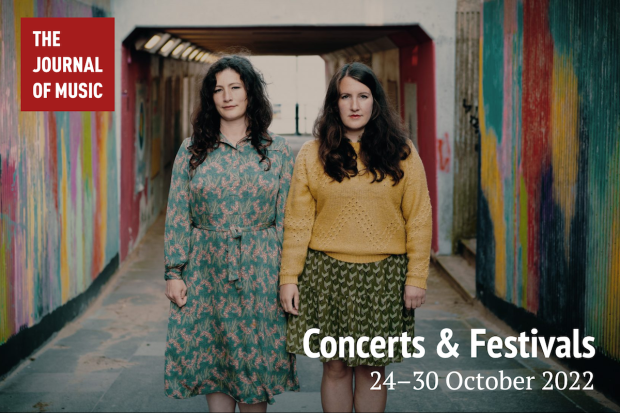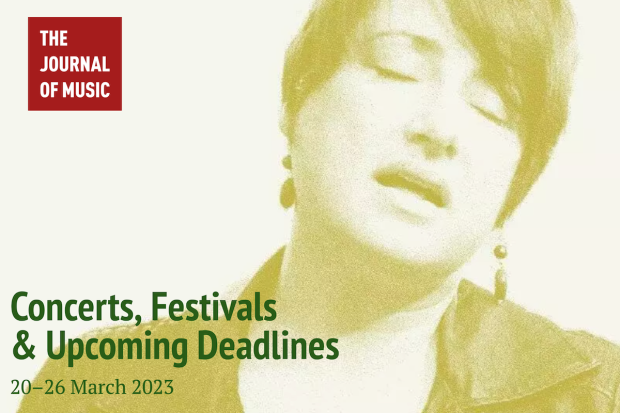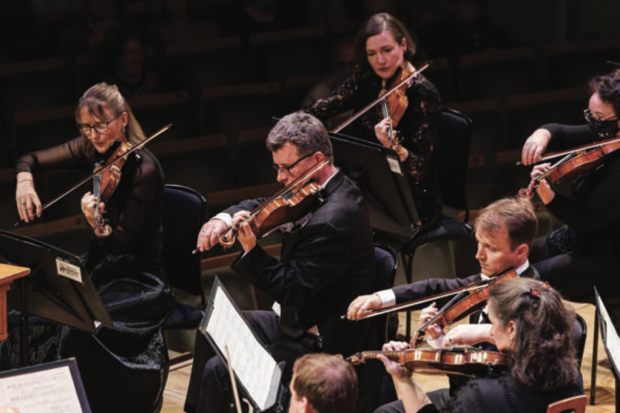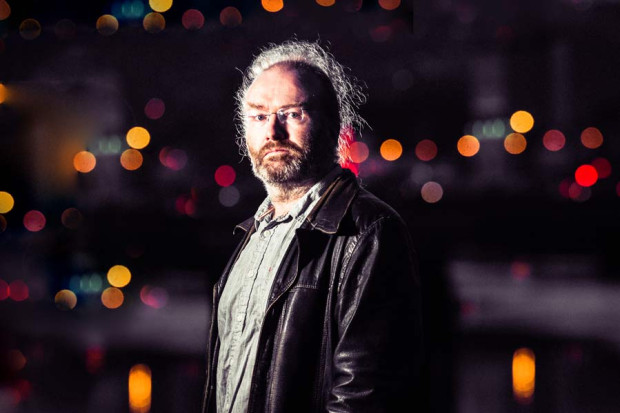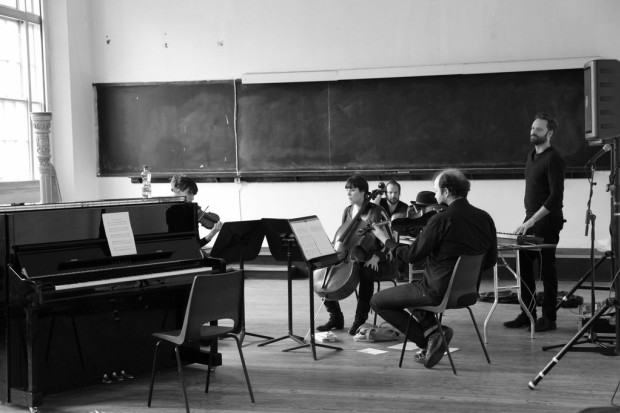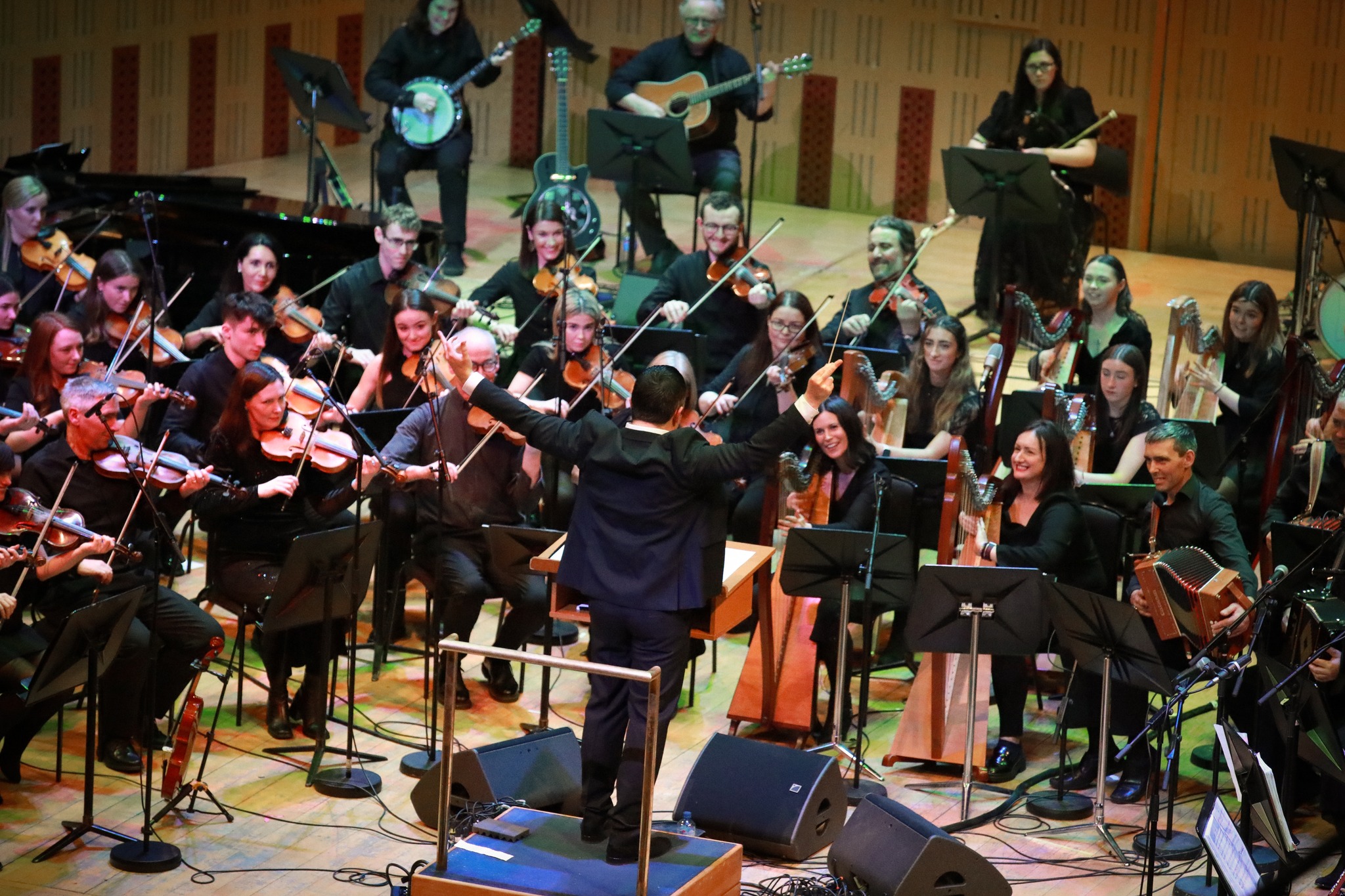
Martin Tourish and the Inishowen Trad Orchestra at the NCH (Photo: Inishowen Traditional Music Project )
A Homecoming Away from Home
Formed in 2019 under the Inishowen Traditional Music Project, the Inishowen Trad Orchestra and Choir performed a large-scale work, also called Inishowen, arranged and conducted by Martin Tourish (with Lorna McLaughlin conducting the choir in tandem) celebrating the music of the northernmost peninsula of the country and challenging reviewers to see how many times they can put Inishowen in a sentence. The work was performed to a packed main auditorium at the National Concert Hall on Sunday 22 January. Though the geographical focus is tight, the temporal span of work performed is immense, including a tune and a poem from the eleventh and tenth centuries respectively, through the Middle Ages and into the last three centuries.
Each section of the work consisted of a number of tunes strung together. It was in this aspect that Tourish’s arrangement worked best, with the tunes flowing completely naturally from one to the next, and each grouping having enough narrative momentum and shape to justify their being called movements.
Each movement was titled, the first named and functioning as an overture, beginning as it did with a rather sugary arrangement of the eleventh century song ‘Deus Meus, Adiuva Me!’ before segueing into two tunes by the renowned fiddler and teacher Dinny McLaughlin: the jig ‘Adam’s Apple’ and a march-like arrangement of the lullaby ‘Carraig Chaoin’.
Past, present, and future
As an exploration of the music of Inishowen, it’s no surprise that such a central figure as McLaughlin featured heavily throughout. If the opening movement can be thought of as an overture, the remainder of the work consciously explores the music of Inishowen’s past, present, and future. And Inishowen really was the heart of the work; there was a sense of community pride and joy in the room. Even before the concert, attendees and performers waved to each other, and Tourish came onstage to a huge cheer even before the audience had taken their seats. As a listener, this led to some conflicted feelings: a good number of the arrangements didn’t work for me. I often found them a bit too sweet, a bit too predictable (though even I’ll grant there were a number of gems). But the music wasn’t made for me; it had an audience in mind already, and I was sharing a room with them.
The second and third movements draw on the work of – and are named for – the much-overlooked nineteenth-century collector Honoria Galwey. The songs in these movements – ‘I Have A Spirit Above My Degree’ and ‘The Young Doctor’ – were particularly striking and Tourish’s arrangements were light of touch and all the better for it. When the whole ensemble played, the accordions and concertinas were always in danger of overpowering the flutes and whistles, but the quieter moments were often very effective.

(Photo: Debbie Hickey, Studio Ten Photography)
Music and poetry of McLaughlin
Dedicated entirely to the music of Dinny McLaughlin, the fourth movement began with ‘Skip About’, a fun tune drawing on early classical influences, and reached its zenith with the choir singing the text of the poem ‘Music’ by McLaughlin and the tenth-century poem ‘The Circuit of Ireland’, while below them the fiddles provided reels (‘Turas go Sliabh Snacht’, ‘Steps Across the River’, and ‘The Jinkin’ Mermaid’) as a countermelody. This was a moment of sincere delight in music-making, a celebratory and triumphant display. It’s a testament to the tune’s catchiness that I’m still singing it to myself as I write this sentence two days later. The group played it again as an encore; they know how good it is.
After the emotional high of the fourth movement, the last is more consciously forward-looking. It featured tunes by the younger generation of Inishowen composers, not least among them Tom Byrne, who was in the button accordion section through the concert, but played a harmonica solo of his Buncrana two-step with boogie-woogie accompaniment on keyboard. More than the others, this movement flowed rapidly between tunes and styles, feeling somewhat like end credits to a movie. There was a set for the harps alone, where the lines wove through each other beautifully, and naturally a reprise, as the work finished with the whole ensemble playing ‘Carraig Chaoin’ again.
The privilege of attending this concert was the opportunity to see and to be among such sincere local pride. Playing to as full an audience as I’ve seen at the National Concert Hall, aged from very young children to the elderly (with even President Higgins in attendance, who received as warm a welcome as the musicians), what did it matter if the music didn’t all work for me? This concert was an unabashed and joyous celebration of the rich musical tradition of the northernmost part of the country, a homecoming away from home.
For more on the Inishowen Traditional Music Project, visit https://inishowenmusic.ie.
Subscribe to our newsletter.
Published on 26 January 2023
Brendan Finan is a teacher and writer. Visit www.brendanfinan.net.










